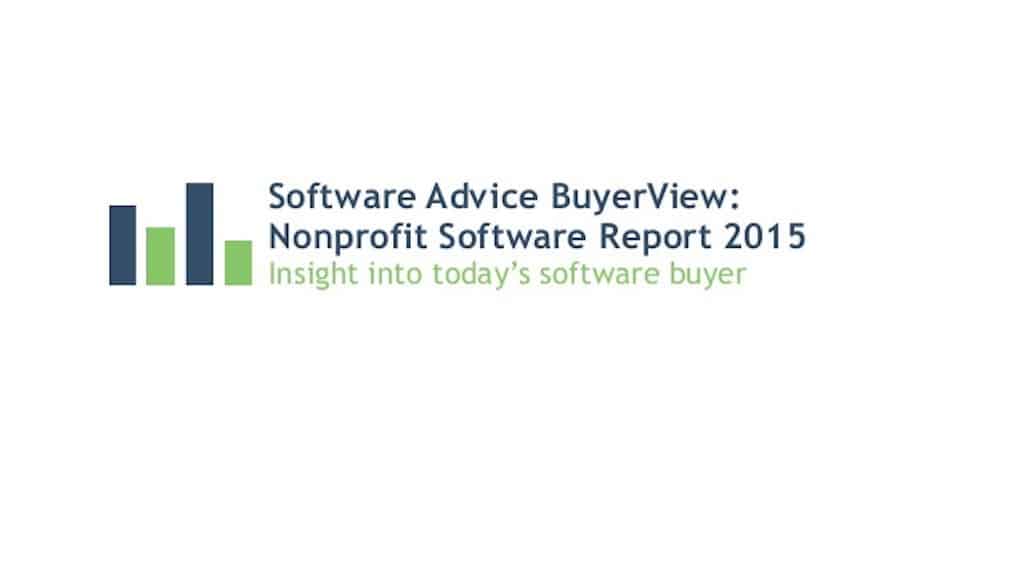
We sat down with Janna Finch, a nonprofit market researcher and contributor to this year’s Nonprofit Software Report, published by Software Advice. Each year, Software Advice talks with thousands of nonprofit managers looking for the right software for their organizations, providing unmatched insight into the needs of software buyers. They recently analyzed a random selection of 200 of these interactions to uncover buyers’ most common pain points and their reasons for purchasing software. We asked Janna some questions about the report’s findings:
GG: What is the biggest barrier to entry you see for nonprofits to adopt software?
Janna: The biggest barrier to software adoption is a lack of knowledge on how to do so. Deciding whether or not an organization needs software is no longer an issue—nowadays, nonprofit professionals know they need some sort of technology to do their jobs well. But determining which software will solve their priority problems and how to go about implementing it is a hurdle that keeps many from making a final decision.
Tip—use online comparison sites like Software Advice to search functionality you need to support your organization, and get help creating a shortlist of products that align best with those needs.
GG: What is the major game changer for 2015 pushing nonprofits towards software?
Janna: There are several important trends in the sector that are compelling nonprofits to adopt more sophisticated technology. One that affects most organizations, however is the continued growth of social media. There’s competition for funding and nonprofits that have figured out how to leverage technology to engage supporters in those spaces are improving their bottom line. Because of the success, other nonprofits are under pressure to adopt software that supports peer-to-peer and other online fundraising campaigns.
GG: What are the three biggest benefits you see from adoption?
Janna: Efficiency. It’s possible to record information about donors, clients, finances and outcomes manually, then crunch numbers in spreadsheets—that’s the way many nonprofits do it. But as an organization scales, it’s tougher and more time-consuming. It doesn’t take long before the majority of staff time is spent on administrative work. Letting software handle things like task reminders, emailing receipts and scheduling volunteers frees up man-hours that are better spent on projects that need a human touch.
Consistency through organizational change. It’s not uncommon to hear that the person who was in charge of managing a part of the business had created their own process, then when that person left, no one else knew what to do. With software in place supporting a particular workflow, the process continues, even if the person who manages it leaves.
Accuracy in reporting. Nonprofits have complex reporting requirements—not only do they have to report on operational and financial activities to the board, management and internal stakeholders, but also regulatory and tax agencies, grantors and other funders. Thus, accurate recordkeeping is imperative. Again, some recordkeeping can be performed manually or with well-designed spreadsheets, but as an organization grows and evolves more “moving parts,” software will support greater visibility of activities and reduce errors.
GG: Predict the next 5 years for us the trend(s) you foresee within software for nonprofits?
Janna: I think the cloud will continue to be a powerful force. It makes software applications easier to manage and more affordable, thereby making technology accessible to those organizations that would otherwise not have the means to implement it.
Another trend I think we’ll hear more about is wearables. UNICEF, through its Wearables for Good challenge, for example, is asking innovators to develop wearable and sensor technology to solve problems in some of the most vulnerable communities of the world. It will certainly be interesting to see what comes from that program, as well as how other nonprofits figure out how to use wearable technology.
GG: What was the most surprising thing to you about this year’s study?
Janna: According to the 2015 Nonprofit Report, an increasing number of NPO’s–41% compared to 30% in 2014—are now using software specifically developed to support nonprofit processes, and fewer rely on manual methods and general-purpose software. This is surprising because our sample is comprised of very small nonprofits—78% have an operating budget of less than $1M—which tells us that nonprofit software usage is growing and there are more affordable software products available now. This is great because keeping good records and automating processes has a huge impact on small organizations.
